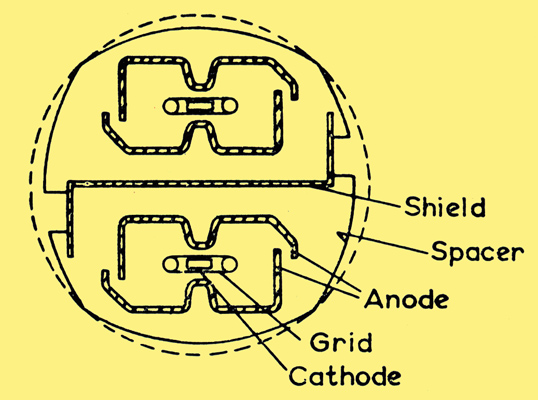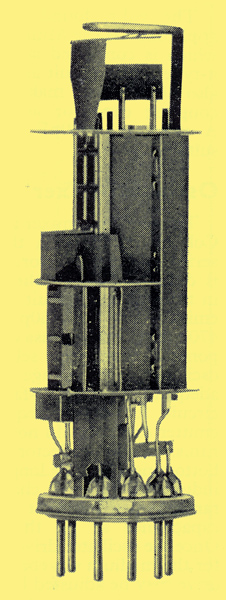|
PCC189 - Cascode RF Amplifier
The Mullard PCC189 double-triode will be encountered in a number of present-day VHF television tuner units. In these units, the triode sections of the valve are connected as a cascode RF amplifier; that is, a grounded-cathode section is coupled in series with a grounded-grid section.
The new valve is particularly suited to this application because it is characterised by low noise, good stability and efficient screening. These properties result from the special construction illustrated in Fig. 1.

Fig. 1 - Special construction of PCC189.
Frame grids are used in both sections. These enable small spacings to be used between the electrodes, so that the time taken for electrons to travel from the cathode to the anode is very short, and good high-frequency performance is consequently ensured. The anodes of both sections are fashioned so that high values of mutual conductance are obtained without incurring increased values of anode-to-grid capacitance. Each section of the valve possesses a variable-mu characteristic. Good cross-modulation performance can thus be achieved and interference between sound and vision carriers eliminated.
The PCC189 is a modified version of the PCC89. A different pinning arrangement facilitates alternative positioning of components in tuner units.
PCF806 - VHF Oscillator & Mixer
The Mullard PCF806 is a triode-pentode intended for use in the mixer stage of VHF tuner units. The triode section is designed to operate as an oscillator, and the pentode section as a mixer.
The design of the triode section is similar to that of earlier oscillator valves, but a slightly higher value (5.5mA/V) of mutual conductance has been attained. This, together with a low amplification factor (17), results in a high effective slope. Consequently excellent oscillator operation, especially at the higher frequencies, can be achieved with PCF806.
The frame grid used in the pentode section results in a mutual conductance of 12mA/V at the working point, and a conversion conductance of 4.5mA/V. This value of conversion conductance is about double that obtainable with mixer valves not using frame grids, and the increase has been achieved without any reduction in input impedance. Hence the conversion gain of the PCF806 is also about double that of the earlier valves. Use of the PCF806 thus means that the design of the subsequent IF amplifier stages can be simplified and the standard of receiver performance considerably improved.
The PCF806 is a modified version of the PCF86, the difference again being in the pin connections.
EH90 - FM Sound Discriminator
Adoption of the 625-line standard is to include the use of FM sound transmissions, and the latest dual-standard receivers are equipped to accommodate these transmissions. The Mullard heptode, type EH90, is being used for FM detection in many of these new sets, where it operates as a locked-oscillator discriminator. The EH90 is used as a dual-control valve in this application: the transmitted signals are applied to the first grid, and the local oscillations to the third grid. Coupling between the two electrodes occurs by way of the electron stream. The circuit depends for its operation on the fact that the mean anode current in the EH90 Will be a function of the phase relationship between signals of similar frequency applied to the control electrodes. As this relationship varies with the signal frequency, frequency modulations at the first grid are converted to demodulated amplitude variations at the anode, and these are subsequently amplified and fed to the loudspeaker.
The electron coupling in the EH90 is good, as is the frequency-to-amplitude transfer characteristic. The valve is thus very suitable for use in this type of discriminator, and will contribute notably to the benefits accruing from the adoption of FM sound transmissions.
PCL86 - Television Audio Output Valve
The Mullard PCL86 AF triode-pentode has been designed specifically for the sound stages of television receivers. The sensitivity of the valve is high enough to allow adequate feedback to be applied in conventional circuits, but is not so high that instability will occur. The high overall gain is achieved partly by a high amplification factor in the triode section, and partly by a high value of mutual conductance in the pentode section. A new cathode material is used in the PCL86 to reduce the likelihood of instability. With this material, there is less deposition of particles from the cathode on other members of the electrode structure.
A special electrode structure, the balcony structure illustrated in Fig. 3, is used in the PCL86. The triode section is much shorter than the pentode section, and heat can therefore radiate freely from the upper part of the pentode section. Greater dissipation can thus be tolerated, and the anode dissipation rating of the PCL86 is consequently particularly high (9W) for triode-pentodes.

Balcony structure of PCL86.
The cathode-to-heater voltage rating of the PCL86 is high (30V), and positioning of the valve in the heater chain is therefore not critical. Screening between the heater and grid leads of the electrode structure ensures a very low level of hum in the valve. The performance to be achieved with the PCL86 is thus very good, and the valve is ideally suited for the sound stages of television receivers.
|